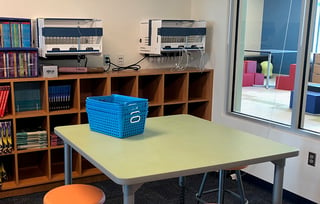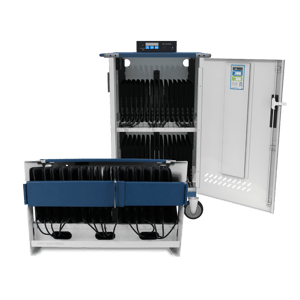For many K-12 students, the decision of where they live and attend school is out of their control, but this can greatly impact the type of access they have to educational technology. For students residing in the rural United States, this technology can provide crucial learning opportunities, but a number of boundaries often limit their access.
In the United States, more than half of school districts and one-third of public schools are located in rural areas. Despite this, many rural communities’ needs are not met in full, particularly with regard to improvements in educational technology and infrastructure.
Taking the digital leap requires reliable access to the Internet, mobile devices, and charging solutions, along with the proper funding. Unfortunately, as a result of restrictive budgets and oversights in public policy, many rural communities have fallen behind their suburban counterparts. They have been slow to fully benefit from the technological advancements available and face a number of barriers to entry, including limited access to affordable charging carts and stations.
Adequate charging solutions are vital components to successfully implementing mobile devices in schools. When it comes to purchasing charging solutions, costs can be prohibitive at times, including the cost of freight shipping carts and larger items. This is particularly true for rural districts who often face inflated shipping costs due to their remote status. Fortunately, there are a number of solutions available that can help to mitigate these costs.
Select the Smartest Carts for Sharing Sets of Devices
Although rural schools are making progress, their pace toward a 1:1 learning environment is slow and greater access to technology is required for technology to become a reliable tool for teaching and learning. To make ends meet in the interim, many of these schools are sharing devices between classrooms to provide their students with equal access to their existing mobile devices. In these instances, it makes sense to invest in a charging cart that will provide teachers and students with the mobility necessary for their devices. This helps make it possible for one person to quickly and easily transport devices from room to room, along with a source for charging, without disrupting valuable class time.
In the search for a charging cart, it is important to look for the solution that will give you the best ROI. Instead of basing your decision solely on the initial purchase cost, consider the quality and overall value as well. This will result in an increase in the usability of the product as well as a lower likelihood that it will require repairs, costing you less in the long run. A low-quality charging cart can actually impede the usefulness of the technology with poor charging methods, bad cable organization, low mobility, and more! Plus, charging carts that are designed to last long-term will often prove to remain useful through future device refreshes.
Keep it Small and Simple with Charging Stations
Charging stations are one of the most popular options for charging in rural environments due to their scalability and affordability. Designed to be modular, it is easy to increase the number of charging stations that are deployed in tandem with increases in the number of devices available. Their compact size also means they are not only easier and cheaper to ship, but often less expensive than mobile charging carts too.
Other convenient features, such as their small footprint and simple design, also mean you have little to be concerned about in terms of space limitations or accessibility. On top of that, many are either able to be stacked together, or conveniently mounted to walls or countertops. This flexibility in their installation options provides especially useful when setting up a central location for charging shared devices in schools that are not yet 1:1.
Cut Costs with Solutions that Ship Unassembled
The up-front costs of charging carts and stations that ship unassembled are often less expensive than those that come fully assembled. This is because due to their compact size, they are able to be shipped as regular packages rather than as freight. When shipped fully assembled via freight, many different cost factors come into play, not only including the packages’ weight and size, but also the shipping distance and time. On the other hand, when shipped unassembled as regular packages, only their weight is taken into account—enabling shipping to be dramatically cheaper.
One downside when investing in unassembled charging solutions, however, is that you are the one who becomes responsible for their assembly. This can quickly become an obstacle if you don’t have the time or resources to configure the product yourself; but even so, you should not discount this option. Many manufacturers and service providers are prepared to arrange affordable on-site assembly, which at the end of the day will still work out to cost less than having the solutions ship assembled.
The Bottom Line
The issue of digital equity is crucial. This holds especially true for rural districts, who struggle to gain access to technological advancements. In terms of their charging options, there is often a significant difference in cost and value for urban schools versus rural schools. These differences are what often make otherwise unaffordable charging solutions affordable and allow schools to outfit more classrooms with charging solutions than previously planned. By truly understanding the implications of each option, we hope to empower rural districts to make more informed purchase decisions when it comes to choosing the right charging solution for their schools.
Get More Value for Money with Easy-to-Ship Charging Solutions At JAR Systems, we believe customers should not face limitations due to their location. For this reason, we have developed a number of charging solutions designed to conveniently ship unassembled, including our Essential 16 Charging Station and Ultra-Light Intelligent Service Plus Cart. Worried about assembly? Don't forget to ask about our affordable on-site assembly services, too!
At JAR Systems, we believe customers should not face limitations due to their location. For this reason, we have developed a number of charging solutions designed to conveniently ship unassembled, including our Essential 16 Charging Station and Ultra-Light Intelligent Service Plus Cart. Worried about assembly? Don't forget to ask about our affordable on-site assembly services, too!
